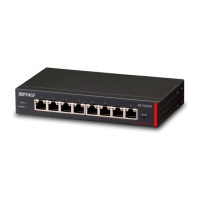SNMP Trap
Configure SNMP traps.
Note: To use SNMP traps, register the host to the host table on the [Basic] - [SNMP] - [SNMP Host Table] page and
enable “trap” for that community.
Compatible traps:
0 coldStart
1 warmStart
2 LinkDown (Link Up/Down)
3 LinkUp (Link Up/Down)
4 authenticationFailure (Authentication Trap)
6 topoligyChange (STP)
7 Loop detection (Loop Detection)
Private MIB OID: 1.3.6.1.4.1.5227.28.1.1.1
8 Trunk (Trunk)
Private MIB OID: 1.3.6.1.4.1.5227.28.1.1.2 (the value differs depending on the trunk’s link status as below)
1.3.6.1.4.1.5227.28.1.2.1 (trunk key 1-8)
1.3.6.1.4.1.5227.28.1.2.2 (link up: 1, link down: 2)
All traps can be enabled/disabled except “coldStart” and “warmStart”.
SNMP Trap Enable or disable all of the following traps.
Authentication Trap
If enabled, the trap will be sent when SNMP is requested from an unallowed IP
address.
Link Up/Down If enabled, the trap will be sent when link up/down of the port is detected.
STP
If enabled, the trap will be sent when STP/RSTP/MSTP topology change is
occurred.
Loop Detection If enabled, the trap will be sent when the loop is detected.
Trunk If enabled, the trap will be sent when the trunk is configured or unconfigured.
24

